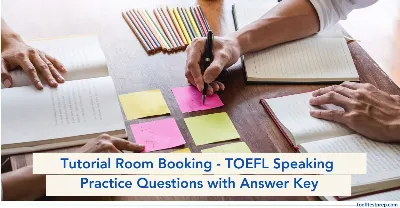Social Media vs Face-to-face Communication - TOEFL Speaking Practice Test (Independent)

"Improve your speaking skills for the TOEFL Independent Speaking section with the practice test on 'Social Media vs Face-to-face Communication' along with sample answers to score higher."
Key Highlights
In the TOEFL Speaking Independent Section of the TOEFL iBT® exam, you have to quickly form and present your opinion on a specific topic. To succeed, you must focus on structuring your response effectively ensuring that your ideas are presented in a clear and logical order. As you prepare, remember that speaking confidently and fluently is critically important without excessive pauses or hesitation. Moreover, supporting your opinion with examples strengthens your argument and helps to make your response more persuasive.
In order to expand the key skills and increase your chances of achieving a high score, you can attempt the TOEFL Speaking Independent Practice Test on 'Social Media vs Face-to-face Communication'. Moreover, working on pronunciation and using varied vocabulary words would ensure that your speech is clear and easy to follow which will help your response stand out. Therefore, it is vital to practice on a regular basis so that you become aware of the structure and improve your skills along the way.
Let's get started!
Instructions:
- You'll receive a familiar topic to speak about with no accompanying reading or listening passages.
- After hearing the question, you will have 15 seconds to prepare your response and 45 seconds to deliver it.
- Remember, 15 seconds might seem short, but it's ample time for preparation.
- For this Question, you'll encounter two situations or opinions and must express your preference, providing reasons for your choice.
Now, play this Audio to hear the Question.
Question:
Some people prefer communicating through social media because it allows them to connect with others instantly, regardless of location. Others believe face-to-face communication is more meaningful and effective. Which do you prefer and why?
Preparation Time: 15 Seconds
Response Time: 45 Seconds
Points to Remember
When addressing the question about social media vs face-to-face communication, consider these key points to craft a well-rounded response. You must clearly state your position and provide specific reasons to justify your opinion. Include relevant examples and maintain a clear, logical organization. Your response should be concise yet detailed enough to demonstrate your speaking abilities within the time limit.
Answer Key with Explanation for TOEFL Independent Speaking Test - Social Media vs Face-to-face Communication
Here, we've included two sample answers, one at a mid-level and one at a high-level proficiency. By comparing the differences in language use, you will gain valuable insights into the key elements that contribute to achieving a higher TOEFL score.
Listen to the audio recording to hear a mid-level answer to the provided question.
Mid-Level Answer Audio Transcript:
I prefer, um, face-to-face communication because it is more, uh, meaningful. When I talk to people in person, I can see their, um, expressions and body language. This is, like, important because it helps me understand them better. Social media, it is, uh, fast but not as deep. I remember a time when I, uh, talked to a friend face-to-face, and it was, like, more effective. Face-to-face is, um, better because it is more personal. Social media is, uh, convenient but not as good. I think face-to-face is, um, more meaningful. It is, uh, better for understanding. Social media is, like, not as effective.
Rater’s Comment:
The response demonstrates significant language errors, such as subject-verb agreement issues in "Social media, it is, uh, fast but not as deep," and tense inconsistency with "I remember a time when I, uh, talked to a friend face-to-face, and it was, like, more effective." Article usage is incorrect in "Social media is, uh, convenient but not as good." Delivery is hindered by excessive filler words like "um," "uh," and "like," leading to unnatural pauses and choppy speech, as seen in "I prefer, um, face-to-face communication." Content development is limited, with repeated phrases like "face-to-face is, um, more meaningful," and lacks supporting details. The response earned a score of 1 due to its minimal coherence and intelligibility. To improve, the speaker should reduce filler words, enhance grammatical accuracy, and provide more detailed content.
Listen to the audio recording to hear a high-level answer to the provided question.
High-Level Answer Audio Transcript:
I prefer face-to-face communication because it allows for a deeper connection and understanding. For instance, when I meet friends in person, I can read their body language and facial expressions, which adds depth to our conversations. This non-verbal communication is often lost in social media interactions. Additionally, face-to-face meetings tend to be more engaging and less prone to misunderstandings. I recall a time when a friend and I resolved a disagreement much more effectively in person than we could have over text. The immediacy of feedback and the personal touch of being physically present made a significant difference. While social media is convenient, I believe the quality of interaction in face-to-face communication is unmatched, making it my preferred choice.
Rater’s Comment:
This response earns a score of 4 due to its effective language use, delivery, and topic development. The speaker employs advanced grammar structures, such as "when I meet friends in person, I can read their body language and facial expressions," demonstrating control over complex sentence constructions. Sophisticated vocabulary choices like "non-verbal communication" and "immediacy of feedback" enhance the response's precision. The delivery is characterised by a natural flow and effective pacing, with clear articulation and smooth transitions, as seen in the seamless shift from discussing body language to resolving disagreements. The content is well-organised, with strong supporting examples, such as the personal anecdote about resolving a disagreement, which illustrates the argument's coherence and progression. The response's notable strengths include its clarity, depth of argument, and effective use of language, all of which contribute to its high-level performance.
Fantastic job working through this practice test! Looking to push your skills further? We have plenty more practice materials ready to help you tackle any speaking challenges you face.
Your dedication to practice will pay off!
Also Read:
Featured Articles

Marriage Across Cultures - TOEFL Reading Practice Test
Improve TOEFL Reading with passages on 'Marriage Across Cultures,' delving into unique traditions, values, and global perspectives on marriage.
July 15, 2025
Writing Center Services - TOEFL Speaking Practice Test with Answers (Integrated)
Prepare for the TOEFL Integrated Speaking section with a practice test on 'Writing Center Services' and learn to improve score in TOEFL exam.
July 15, 2025
Tutorial Room Booking - TOEFL Speaking Practice Test with Answers (Integrated)
Prepare for the TOEFL Integrated Speaking section with a practice test on 'Tutorial Room Booking ' and learn to improve score in TOEFL exam.
July 15, 2025
Textbook Rental System - TOEFL Speaking Practice Test with Answers (Integrated)
Prepare for the TOEFL Integrated Speaking section with a practice test on 'Textbook Rental System' and learn to improve score in TOEFL exam.
July 15, 2025